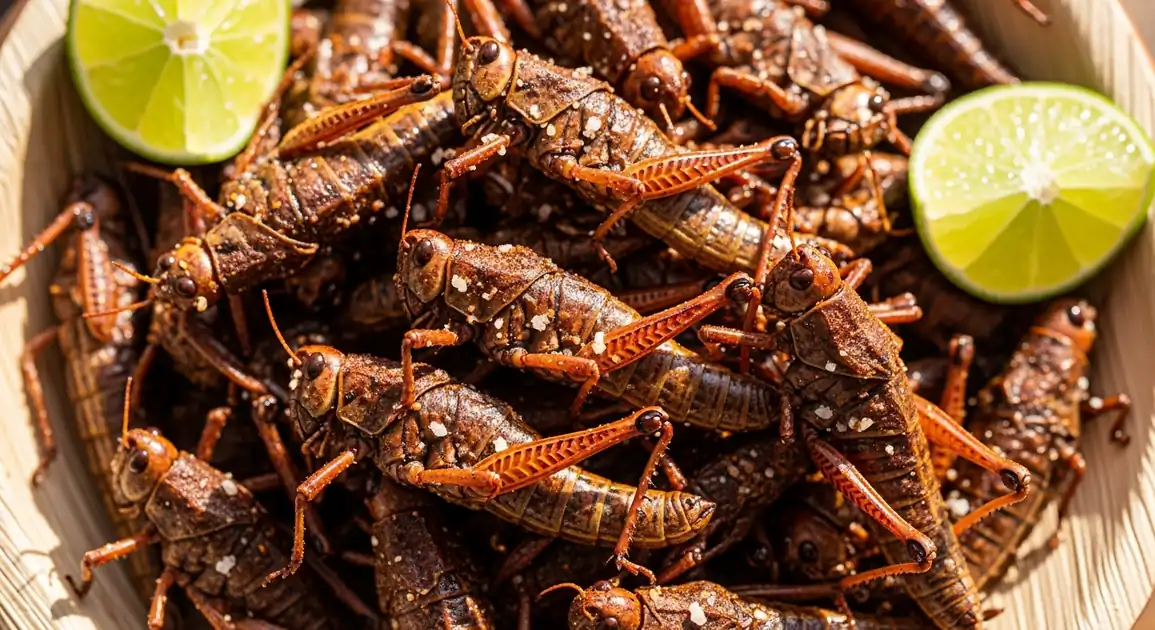Chapulines (Toasted Grasshoppers)
Chapulines

Description
Chapulines are deeply embedded in Mexico's culinary heritage, particularly in the southern regions. While historically most associated with Oaxaca state, they can now be found throughout the country's major cities and food markets. The quality, preparation methods, and serving styles vary regionally, with traditional markets offering the most authentic experience.
Dietary Information
Serving information
Serving style
Typically served in small bags or cups in markets, often with lime wedges. In restaurants, may be presented in small clay dishes or as a topping on traditional dishes.
Quick facts
Market vendors typically operate from 8 AM - 6 PM. Restaurant and mezcalería offerings available during their business hours, usually until 10 PM - 12 AM.
Safety Tips
What to Look For
-
Uniform reddish-brown color
Properly toasted chapulines should have a consistent color without black (burnt) or pale (undercooked) specimens.
-
Completely dry and crispy texture
Chapulines must be thoroughly toasted to eliminate any pathogens and ensure food safety. They should snap when broken, not bend.
-
Clean, sorted product
Quality vendors carefully clean and sort their chapulines, removing debris, dirt, and extraneous parts.
-
Fresh, aromatic smell
Good chapulines have a pleasant aroma of lime, garlic, and chile. Avoid any that smell musty, rancid, or off.
-
Vendors with high turnover
Busy stalls typically have fresher product and maintain better quality control.
What to avoid
-
Damp or soft chapulines
Inadequately toasted chapulines may contain harmful bacteria. They should never feel moist or soft to the touch.
-
Black or very dark specimens
Burnt chapulines taste bitter and may contain harmful compounds from overcooking.
-
Chapulines with visible dirt or debris
Poor cleaning indicates substandard preparation practices that may impact food safety.
-
Stale or off-smelling product
Old or improperly stored chapulines can develop mold or rancidity. They should smell fresh and appetizing.
-
Exceptionally cheap prices
Quality chapulines require labor-intensive preparation. Suspiciously low prices may indicate shortcuts in cleaning or preparation.
Price information
Price range
Budget tips
- Small portions (about 30g) typically cost 20-40 MXN in markets.
- Prices are generally lower in non-tourist areas and direct from producers.
- Buying larger quantities (100g+) usually offers better value.
- In restaurants, chapulines as a topping might add 30-50 MXN to a dish.
Value indicators
- Careful sorting by size.
- Uniform toasting without burnt pieces.
- Fresh, aromatic smell of lime and spices.
- Clean product without debris.
- Appropriate crispness.
Where to Find This Dish
Traditional Markets
The primary location for purchasing chapulines throughout Mexico.
Mercado sections specializing in Oaxacan products, Dried goods sections
Morning, Early Afternoon
Tourist Areas
Specialized vendors targeting visitors wanting to try traditional foods.
Pedestrian zones, Areas near archaeological sites
Afternoon, Evening
Mezcalerías and Traditional Restaurants
Served as appetizers or accompaniments to drinks.
Mezcal-focused establishments, Restaurants advertising traditional cuisine
Evening, Night
Vendor Tips
- Ask when they were toasted - fresher is better.
- Look for vendors who store chapulines in covered containers, not open to the air.
- Vendors happy to offer small samples usually have confidence in their product.
How to Order
Regional Variations
-
Chapulines with Chile
(Chapulines con Chile)
Seasoned with additional chile powder or sauce for a spicier flavor profile. Popular in central Mexico.
-
Garlic Chapulines
(Chapulines al Ajo)
Emphasis on garlic flavor with minimal chile, often preferred by those who enjoy the natural taste of the insects without too much heat.
-
Chapulines with Epazote
(Chapulines con Epazote)
Traditional Oaxacan preparation including epazote herb, which adds an aromatic, minty flavor and is said to aid digestion.
-
Large Chapulines
(Chapulines Grandes)
Larger specimens, often sorted specifically for their size. They have a more substantial crunch and are typically more expensive.
-
Small Chapulines
(Chapulines Chicos)
Smaller, younger grasshoppers with a more delicate texture. Often preferred for adding to dishes as they integrate better.
-
Chocolate-covered Chapulines
(Chapulines con Chocolate)
A modern fusion preparation where chapulines are coated in Mexican chocolate. Popular in upscale restaurants and with tourists.
Cultural context
History
Chapulines have been consumed in Mexico since pre-Hispanic times, with archaeological evidence dating back thousands of years. Indigenous peoples, particularly Zapotecs and Mixtecs in what is now Oaxaca, harvested these protein-rich insects as a sustainable food source. The Spanish conquest documented their culinary use in the 16th century. Traditional preparation methods have been passed down through generations, with each region developing particular seasoning preferences. While historically associated with rural and indigenous communities, chapulines have gained popularity nationally and internationally as interest in traditional Mexican cuisine and sustainable protein sources has grown.
Local significance
Chapulines represent Mexico's pre-Hispanic culinary heritage and sustainable food practices. They're a symbol of regional identity, particularly for Oaxaca.
Eating customs
- Often consumed with a squeeze of fresh lime.
- Typically eaten by hand as a snack or sprinkled onto other dishes.
- In social settings, offered to guests as a sign of hospitality and cultural pride.